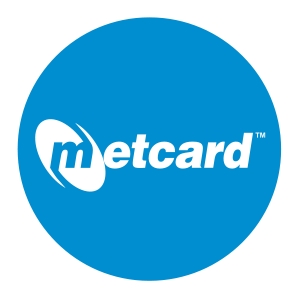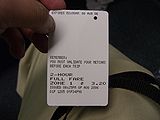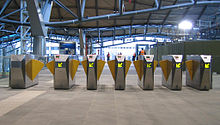- Metcard
-
"OneLink" redirects here. For the computer/cable company, see OneLink Communications.
Metcard is the brand name of an integrated ticketing system used to access public transport in Melbourne, Australia.[1] It is a universal ticket which allows users to ride on the city's Metlink network, consisting of suburban trains, trams, and buses, including the NightRider network. The Metcard is a credit card sized ticket made out of cardboard and uses a magnetic strip to store fare data. Metcard is operated by OneLink Transit Systems under a contract to the State Government which is managed by the Transport Ticketing Authority.[2]
Contents
History
In July 1983, the Metropolitan Transit Authority was formed to integrate Melbourne's tram, train, and bus services. The Metropolitan Transit Authority also integrated bus, train, and tram ticketing using punch tickets and scratchies. Under the arrangements, the State Government collected all revenue from the sale of multi-modal tickets, which was then allocated to the various operators on an agreed formula basis.
Moves towards automated ticketing were first made in 1992. Tenders were called for the design, supply, installation and on-going maintenance of the system, with the 'OneLink Transit Consortium' becoming the preferred tenderer in September 1993. The contract was signed in May 1994, with the major technology supplier being the ERG Group.[3]
Testing of prototypes commenced in December 1993, and the roll-out of the system was carried out from August 1996 to April 1998. Public field trials were carried out on buses from August 20, 1996, and on rail services from September 18, 1996.[4] Acceptance occurred in November 1997.[3] The system commenced full revenue service from May 1998 at a cost of $330 million.[5] Contractual issues between OneLink and the Victorian Government were not settled until May 2002 with the payment of up to $65 million in a staged settlement.[6]
In 2002, Metcard replaced the functionally identical yet technically simpler punch tickets and scratchie tickets, which were easy to cheat.[7] Controversy surrounded Metcard at its introduction, due to cost over-runs, the abolition of tram conductors and the unreliability of ticket purchasing and validation machines. The machines were attacked by vandals frequently (often by pouring liquids into the coin slot), and have seen several revisions to their design since.[8]
An audit released by the State Government in 2001 showed over 1 in 4 (27.2%) of the machines at train stations did not work, and 11.9% of mobile equipment in buses and trams was non-operational.[9] The State Government renegotiated with ticketing network contract operator OneLink Transit Systems to improve the service to commuters. Following these improvements, a 2002 audit showed an increase in availability of machines to 92.1% at train stations, and 98.3% on buses and trams. Usability was also improved, with tram machines able to sell daily tickets. Furthermore, vandalism across the network dropped by 62% between 2001 and 2002.[8]
V/Line tickets were aligned with the Metcard system in April 2006, with each V/Line ticket to stations in the Metcard area having the relevant zones printed on them.[10] In March 2007 the Nightrider bus service was also brought under the Metcard system.[11] and zones 2 and 3 under the Metcard system were merged as zone 2.[12]
The original Metcard contract with OneLink was to last nine years, expiring in March 2007. In 2005 the contract was amended to permit the system to be extended and modified as work on the replacement myki project progresses, with the contract being able to be terminated on six months notice.[2]
Discarded Metcards are often used as a roach in cannabis cigarettes.
Operation
 A 'small' MVM 1 Metcard vending machine
A 'small' MVM 1 Metcard vending machine
All forms of public transport can be accessed by using a single Metcard. Metcards are a time and zone based ticket, with validity periods ranging from 2 hours to yearly, and two zones covering the Melbourne metropolitan area. Further information on the range of Metcards available is published in Metlink's Victorian Fares and Ticketing Manual.
Metcards can be purchased in the following ways from:
- Rail stations Ticket Vending Machines
- Ticket Vending Machines on board trams and the Stony Point train
- Bus drivers
- (staffed) stations
- The Met Shop (inside the Melbourne Town Hall on Swanston Street)
- Authorised Metcard outlets such as newsagencies and milk bars
- The Internet http://store.metlinkmelbourne.com.au/
- Phone orders (1 800 652 313)
Ticket availability varies, with the sources above each stocking slightly different ranges beyond the standard two-hour, daily and seniors tickets.[13] Availability on board buses is particularly restricted, with neither the Sunday Saver nor off-peak tickets being available from drivers. Similarly ticket vending machines at railway stations do not stock Sunday Savers or some types of off-peak tickets. Payment options vary from coin-only (small Metcard machines on trams and at railway stations), EFTPOS, coin and some notes (large ticket machines at stations) to EFTPOS, credit card, coin and all notes (premium railway stations).
In March 2008 the new 401 shuttle bus service between from North Melbourne railway station to the Royal Melbourne Hospital and University of Melbourne became the first (and as of 2009 the only) bus route in Melbourne that requires the purchase of a Metcard before travel.[14][15]
Metcards are 'validated' when entering or exiting railway stations, and getting on trams or buses. The first validation prints an expiry date and time on the back of the ticket. Subsequent validations of most types of tickets do not print extra times but the data was intended to be used to count passenger numbers (in order to improve transport services). Revalidation of already validated tickets, whilst functionally unnecessary, is still required by law[1] and occasional campaigns continue to remind passengers of this.
When transport operations were franchised, revalidation data was also used to apportion revenue share between operators.[3] This has since been abandoned in favour of fixed percentage allocations (40% train, 40% tram and 20% bus).
With the lack of barriers at all but a few major railway stations and trams not having conductors, enforcement is the responsibility of roaming Authorised Officers (ticket inspectors). Authorised Officers (AOs) check that passengers have the correct ticket and, if using a concession ticket, have a suitable concession card. AOs do not issue fines directly but issue an infringement notice. The passenger then receives a letter from the Department of Transport, who may issue a fine. They can either pay the fine, or contest it by letter or in court.[16]
Zones and fares
The Melbourne ticketing system is based on 'Zones' and calculated depending on travel zone, with higher fares for trips that include both travel Zones. The Melbourne zonal fare system is broken up into two ticketing Zones: Zone 1 (Yellow) and Zone 2 (Blue). The two zones form concentric rings, with Zone 1 comprising the inner suburbs, and Zone 2 covering the remainder of metropolitan Melbourne. Zone overlap areas exist on the borders of the two zones. In these areas tickets for either zone are acceptable.[17]
A separate fare and ticketing system exists for V/Line (country) services. However, since April 2006 holders of V/Line tickets to Melbourne have access to both Zone 1 and 2, while V/Line tickets to Zone 2 stations are valid for Zone 2 only.[18] Fares in most towns just outside Melbourne were also aligned to Zone 2 Metcard prices as part of this integration.[10]
A range of tickets are available, including two-hour, all-day, weekly, monthly and annual tickets. There are also concession tickets for students, seniors and others. As of 2010, a daily Zone 1 full-fare (as distinct from concession fare) ticket costs A$6.80 , and a weekly Zone 1 ticket costs A$29.40. Prices generally rise by inflation (CPI) on January 1 each year, though there have been occasional higher than CPI increases.[19]
Future
The Metcard system was scheduled to be replaced in 2008 by a RFID-based ticketing system called myki, which will also cover all public transport in the state.[20] However in February 2008 Victorian Public Transport Minister Lynne Kosky announced that the full roll out of the system would not begin until the end of 2008.[21] Approximately 7 weeks later, the system was delayed for approximately another 2 years, with an announcement that the service was now scheduled to begin its roll out in 2009, but not be fully operational until some time in 2010.[22] The system has now been introduced on metropolitan train services, and was introduced on bus and tram services on July 25 2010. [23]
The two systems would coexist until the transition is complete. The current Metcard equipment supports a similar system based on re-usable RFID touch cards for use by public transport staff and other pass holders,[24] however this provides neither the flexibility nor advantages intended to be brought by the new system.
Transport minister Martin Pakula has announced recently that Myki will be valid on trams and buses on sunday the 25th July 2010, nearly 7 months after the initial launch on trains operated by Metro Trains Melbourne. However Martin couldn't say a date for when Myki will be rolled out on V/Line coaches and trains.
The new system has been announced as a Touch On / Touch Off system, where two validations are required per journey; one when boarding and again when alighting, similar to the London Underground's Oyster card system.[20] This means passengers will have a single card and be charged for the actual fare used (flat rate fare). This is unlike the current system where passengers who travel into different zones at different days and times may need to buy several types of Metcards beforehand.
Touch On / Touch Off has both benefits and costs. On one hand it allows fares to be automatically calculated, always giving the passenger the cheapest fare option. Also, unlike Metcard, special off-peak fares to encourage travel during quiet times could be implemented, for example. The main cost will likely be borne by passengers who do not Scan Off, which is easy to forget. Such passengers will likely be charged the 2 hour Zone 1+2 fare.[20]
In June 2011, the Victorian Government confirmed that myki will continue and that metcards will no longer be available after December 2012.
See also
References
- ^ a b "FAQs - Metlink - Your guide to public transport in Melbourne and Victoria". www.metlinkmelbourne.com.au. http://www.metlinkmelbourne.com.au/fares_tickets/faqs. Retrieved 2008-03-26.
- ^ a b "Transport Ticketing Authority Corporate Plan 06-07" (PDF). www.doi.vic.gov.au. Archived from the original on 2007-12-19. http://web.archive.org/web/20071219022714/http://www.doi.vic.gov.au/doi/doielect.nsf/2a6bd98dee287482ca256915001cff0c/fc6ee506c2ec4189ca2571fd001fe7c7/$FILE/TTA-CP-2006-09.pdf. Retrieved 2008-03-27.
- ^ a b c "Metcard - A brief history". www.robx1.net. http://www.robx1.net/victkt/metcard/html/history.htm. Retrieved 2008-03-26.
- ^ "Metcard - Public Field Trials". www.robx1.net. http://www.robx1.net/victkt/metcard/html/pft.htm. Retrieved 2008-03-26.
- ^ "ERG Limited: Case Studies - Melbourne". www.erggroup.com. http://www.erggroup.com/worldwide/details.asp?pid=7. Retrieved 2008-03-27.[dead link]
- ^ "Media Release: SETTLEMENT OF ONELINK DISPUTE PAVES THE WAY FOR PUBLIC TRANSPORT TICKETING REFORM". MINISTER FOR TRANSPORT. www.legislation.vic.gov.au. May 30, 2002. http://www.legislation.vic.gov.au/domino/Web_Notes/MediaRelArc02.nsf/fce5683f42af57f04a256b36001bd4df/415280cae994e99eca256bc9007c8c79!OpenDocument&Click=. Retrieved 2008-03-27.
- ^ "Metcard - The End of Met Ticket". www.robx1.net. http://www.robx1.net/victkt/metcard/html/finale.htm. Retrieved 2008-03-27.
- ^ a b Downie Consulting (March 2003). "2002 Independent Audit of the Automatic Ticketing System" (PDF). www.doi.vic.gov.au. Archived from the original on 2007-12-19. http://web.archive.org/web/20071219023347/http://www.doi.vic.gov.au/doi/doielect.nsf/2a6bd98dee287482ca256915001cff0c/212e8a4e99367bc9ca256cf5007b7a44/$FILE/ReportDraft12-+Downie+modified+12.02.03.pdf. Retrieved 2008-03-27.
- ^ Miller Network Group (May 2001). "2001 Independent Audit of the Automatic Ticketing System". www.doi.vic.gov.au. http://www.doi.vic.gov.au/doi/internet/transport.nsf/AllDocs/AB742159B0AB04EC4A25699A000055E5?OpenDocument#01audit. Retrieved 2008-03-27.
- ^ a b "Media Release: BETTER VALUE FOR V/LINE TICKETS FROM THIS SATURDAY". www.dpc.vic.gov.au. April 20, 2006. http://www.dpc.vic.gov.au/domino/Web_Notes/newmedia.nsf/8fc6e140ef55837cca256c8c00183cdc/48834ff802d37191ca25715600825dcd!OpenDocument. Retrieved 2008-03-26.
- ^ "Media Release: NIGHTRIDER NOW INCLUDED IN METCARD FARE". www.dpc.vic.gov.au. March 2, 2007. http://www.dpc.vic.gov.au/domino/Web_Notes/newmedia.nsf/955cbeae7df9460dca256c8c00152d2b/d83e569f8d09c594ca257294007887d9!OpenDocument. Retrieved 2008-03-26.
- ^ "Media Release: REMOVAL OF ZONE 3 MEANS SAVINGS FOR PASSENGERS". www.dpc.vic.gov.au. March 4, 2007. http://www.dpc.vic.gov.au/domino/Web_Notes/newmedia.nsf/35504bc71d3adebcca256cfc0082c2b8/92cdc0165023aa5bca257294007b9355!OpenDocument. Retrieved 2008-03-26.
- ^ "Metcard types - Metlink - Your guide to public transport in Melbourne and Victoria". www.metlinkmelbourne.com.au. http://www.metlinkmelbourne.com.au/fares_tickets/metropolitan_fares_and_tickets/metcard_types. Retrieved 2008-03-26.
- ^ "Media Release: NEW SHUTTLE SERVICE PROVIDES VITAL LINK FOR COMMUTERS". www.dpc.vic.gov.au. March 3, 2008. http://www.dpc.vic.gov.au/domino/Web_Notes/newmedia.nsf/798c8b072d117a01ca256c8c0019bb01/ae68b4f8991d03caca257401007bfe06!OpenDocument. Retrieved 2008-05-21.
- ^ "New bus route from North Melbourne Station - via Royal Melbourne Hospital - to the University of Melbourne: from Monday, 3 March 2008 - Metlink - Your guide to public transport in Melbourne and Victoria". www.metlinkmelbourne.com.au. http://www.metlinkmelbourne.com.au/news/service_alterations/metropolitan_buses/new_bus_route_from_north_melbourne_station_via_royal_melbourne_hospital_to_the_university_of_melbourne_from_monday_3_march_2008. Retrieved 2008-05-21.
- ^ "Public transport - Public transport fines". www.transport.vic.gov.au. http://www.transport.vic.gov.au/DOI/Internet/transport.nsf/AllDocs/5AB5715FBF5BB9D0CA256F1F00087DF2?OpenDocument. Retrieved 2008-03-26.
- ^ "Metropolitan zones - Metlink - Your guide to public transport in Melbourne and Victoria". www.metlinkmelbourne.com.au. http://www.metlinkmelbourne.com.au/fares_tickets/metropolitan_fares_and_tickets/metropolitan_zones. Retrieved 2008-03-26.
- ^ "V/Line: V/Line & Metlink ticket integration". www.vline.com.au. http://www.vline.com.au/fares/fares/vline_metlink_integration.html. Retrieved 2008-03-26.
- ^ Stephen Moynihan (November 28, 2007). "Public transport fares to rise - National - theage.com.au". www.theage.com.au. http://www.theage.com.au/news/national/public-transport-fares-to-rise/2007/11/28/1196036950574.html. Retrieved 2008-03-26.
- ^ a b c "Chapter 7 - Myki ticketing solution" (PDF). Victorian Fares and Ticketing Manual (2008). http://www.metlinkmelbourne.com.au/.+Archived+from the original on 2008-08-22. http://web.archive.org/web/20080822224609/http://www.metlinkmelbourne.com.au/content/download/34677/459749/file/3319+FT+Manual+08+WEB+CHP07.pdf. Retrieved 2008-03-26.
- ^ The Age: Smartcard Runs Two Years Late - 5 February 2008
- ^ The Age: Smartcard System May Face Two Year Delay February 5, 2008
- ^ "Myki Latest News". myki.com,au. http://www.myki.com.au/Home/Latest-news/Latest-news/default.aspx. Retrieved 2010-11-01.
- ^ "Metcard - Employee Touchcards". www.robx1.net. http://www.robx1.net/victkt/metcard/html/employee.htm. Retrieved 2008-03-26.
External links
- Metlink fares & tickets - official website
- PTUA - Your Rights on Melbourne's Public Transport
- PTUA - Ticketing & Smartcard FAQ
Melbourne's public transport - Metlink Modes and network Ticketing Metcard • mykiMetropolitan rail operators Regional rail operators Metropolitan and regional bus operators Broadmeadows Bus Service • Cardinia Transit • Cranbourne Transit • Driver Bus Lines • Dyson's Bus Services • Eastrans • East West Bus Company • Grenda's • Hope Street Bus Line • Invicta Bus Services • Ivanhoe Bus Company • Kastoria Bus Lines • Martyrs Bus Service • Melbourne Bus Link • McKenzie's • Moonee Valley • Moorabbin Transit • Moreland Buslines • NationalBus • Panorama Coaches • Peninsula Bus Lines • Portsea • Reservoir • Ryan Brothers Bus Service • Sita Buslines • Skybus Super Shuttle • Sunbury Bus Service • Tullamarine Bus Lines • US Bus Lines • Ventura Bus Lines • WestransPlanned infrastructure Authorities Categories:- Fare collection systems
- Public transport in Melbourne
Wikimedia Foundation. 2010.



